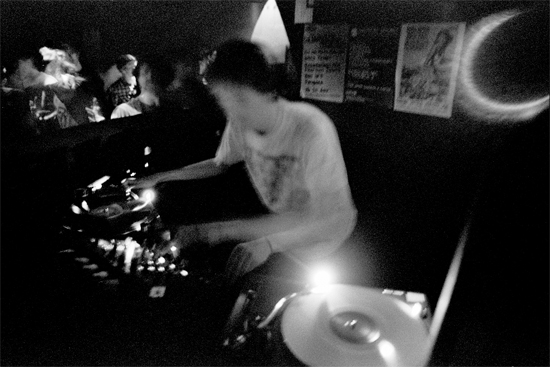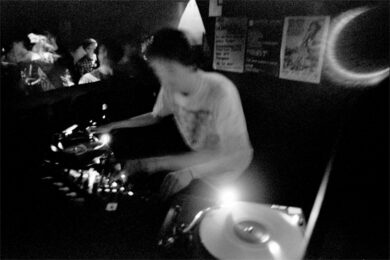UK dance music has always seemed to me a bastion of the modernist outlook. Long after guitar bands manfully decided to shoulder the vast burden of their past, and chart pop, driven by the commercial imperatives of maximum gain for minimum risk, turned round to gag on its own tail, ideas of ‘the future’ still seem to hold sway on the dancefloor. Take the term ‘future garage’: misguided it may be, given the lack of adventurousness that typifies most of the genre (which largely consists of plaid shirt-friendly xeroxes of Burial classics). But nonetheless, the sentiment is there: these are musicians aligning themselves with an idea of ‘tomorrow’, rather than invoking a stylised vision of the past.
Don’t get me wrong, dance music has its fair share of retrogressive tendencies – more so now than ever – but the idea of the ‘futuristic’ continues to have a kind of totemic power among many producers, DJs and club-goers. EDM disciples are still beholden to concepts of ‘hi-tech’ and ‘evolution’ – indeed, scientific analogies feature heavily in the lexicon, with both Darwinian and genetic theories often being used to describe the music’s development (I actually found it impossible to write this piece without drawing on said analogies, so keep an eye out for them).
Another fine – and more enduring – example of this mindset would be FWD>>. From the name, with its implications of linear progression, to the sleek, functional visual aesthetic provided by Give Up Art, the London clubnight credited with bringing dubstep to the world has never felt the need to wallow in the trappings of its heritage. Fortunately, the music has lived up to its packaging. For the last decade, the seeds sown by a few dozen producers and devotees in a darkened room have grown and grown into a global phenomenon. A decade is a nice round number, isn’t it? Some kind of celebration is probably in order.
Living in the ghetto of South London as I do, a visit to Brick Lane constitutes something of a red-letter day. Passing by its dozens of curry houses, I find the experience of having a sit-down meal aggressively promoted to me on the street by another human being very distracting (this is probably due to a mixture of my confrontation-phobic British middle-class upbringing and an adolescence mediated through a series of backlit screens). So distracting, in fact, that it takes me a period of wandering around, saucer-eyed from lack of social contact, before I spot the glaringly obvious A1 posters and crowd of likely looking types which indicate that I’ve reached my warehouse destination.
The long, snaking queue I join brings to mind a prime characteristic of modernism as a view of culture: its linearity. We started at point A (in this case, a dingy corner next to a skip) and, at some notional future point we will reach Z, or so the idea goes. Each successive point in the journey builds on what’s gone before it; progression, or improvement, is an inherent quality of moving forward. How fitting then, that tonight we’re given a DJ to represent every year of the clubnight’s history; each performer a familiar name who, in their turn, left an indelible mark on dubstep’s evolution. How will the narrative read, laid out on a soundsystem for all to enjoy?
It should be said that my left-brained need for order is instantly undermined by the pragmatic demands of clubland: the DJs aren’t playing in sequence. Hatcha, representing 2003, has a peaktime slot elsewhere and isn’t on till dawn (well past my bedtime). Other DJs are also shuffled around, leading me to miss, among others, the ever-bumpin’ Ben UFO’s opening slot. But as the night progresses, a tentative kind of narrative does begin to emerge. The front end of the decade is represented early on by the brittle breakbeat of Zinc and Oris Jay, very much a retooling of garage’s feminine flex, softness and curves extracted, gun fingers and sweat left in. Its snarling bass and clattering drumwork is thrilling, but it’s a cheap kinda thrill, significant as a pivot point between the dominant sounds of early 2000s London and what was to come, but lacking the dizzying potential buried in dubstep’s DNA.
Slimzee throws a curveball in at 2004, bringing the hyperactivity of grime into play – a reminder that dubstep isn’t, and has never been, the only kid on the block. At times, his beats seem to foreshadow the playful bounce of UK funky and bassline house; they certainly retain a lopsided grin – albeit a thuggish one – at a time when their close cousins were set firmly on the path to skunk-fugged paranoia.
With midnight left behind, Youngsta draws us into the dark, throbbing nexus of 2005: arguably dubstep’s finest year, certainly its purest. By this point, dread – in both the JA and OED meanings of the word – has become an integral part of the mixture, supplying the dubwise sense of space and creeping urban dystopianism which has made the sound both quintessentially London and universally appealing. Ever the technical DJ, Yunx plays the baying crowd to perfection, teasing us with signature motifs from tracks that never materialise, then detonating bombs of recognition with minimal warning – the Loefah remix of Skream’s ‘I’ proves particularly destructive. It’s telling that the vibe of a 2011 Youngsta set is almost identical to what he pulls out tonight, even though he plays as much new material these days as he ever has. Much as certain strands of drum & bass have endured through the years in recognisable form without fossilising entirely, this is a sound with lasting appeal and almost limitless scope for tweaks and micro-innovations.
Beyond that mid-decade critical mass, things start to get complicated. 2006 and 2007 are represented by dubstep poster-boy Skream and Hyperdub boss Kode9 respectively, seemingly forming part of a sequence, but in reality showcasing the emergence of a fissure. Skream embodies dubstep’s potential for global domination. His set is a mixture of joyous bubblegum dub and skrewfaced bassline acrobatics, firmly aimed at main room crowds; the melodies are strident and brightly coloured, bolted onto simple but hulking percussive frameworks, drops hyped almost into oblivion.
Kode9, on the other hand, turns in an hour of deep esoterica, charting the outer terrain of his chosen era through a mixture of technoid-bass hybrids and savagely mutated dancehall (The Bug’s ‘Poison Dart’ is the first tune of the night, by my count, to earn two successive rewinds). Not to mention premonitions of Hyperdub’s soon-come colourful new direction, including a garish Quarta 330 remix of Kode’s classic ‘9 Samurai’ which pummels the room into 8-bit submission. Ending his set on Burial’s sublime ‘Archangel’ isn’t a shock move (Skream did it for months after the record was released), but acts as a reminder that dubstep was already making serious power moves by this point.
Both of these sets reveal an array of stunning possiblities for dubstep, most of which have been realised in the years since. Skream, along with running mate Benga, revitalised dubstep at a point when it risked stagnation, launching it – and himself – into the mainstream in the process. Kode9, meanwhile, spearheaded a surge of renewed energy in the underground, embracing eclecticism whilst cementing dubstep’s place in a new world order which valued pluralism over singular focus.
By the time Marcus Nasty steps up, signalling UK Funky’s arrival on the scene in 2009, peaktime has passed and there’s a mass exodus from the cavernous warehouse that FWD has called home for a night. The sound, which has, disappointingly, been sub-par all night, rattles around the vast space, no longer soaked up by a mass of bodies. What’s probably a fine hour of grinding, tribal beatwork is swamped in a confusion of hi-end noise, the MC’s feed strangled by piercing feedback. It proves too much for this writer to bear, and I make my exit not long after.
It’s a shame that the high couldn’t have lasted for longer. But the realist in me says that all things have their life span, and attempting to overreach it doesn’t always lead to a positive outcome. FWD has reached a tipping point of sorts. Its initial core energy, that nucleus of modernist ambition that has driven it forward for ten years, has become dispersed across the musical landscape of the new decade. Whether they’re busy keeping their own house in order (Kode9), storming the charts (Skream), or puritanically cleaving to the old ways (Youngsta), the minds that made FWD what it is are no longer part of the avant-garde; they are the establishment. The clubnight has every right to look back over its successes and pat itself on the back – this is music that deserves to be remembered as some of the finest of its time – but its organisers should be wary of allowing their past to overwhelm their present, falling into the trap of endless ‘x year revival’ shows with the same familiar faces (lord knows it’s happened to enough dance music institutions in the past).
As the choice of Oneman and Ben UFO to represent the past two years shows, UK electronic music is probably engaged in more outwards – (Oneman’s sets are often hyper-eclectic) and backwards – (Ben UFO hops across decades with virtuosic ease) gazing than ever before. That’s not to denigrate the musical forces that these two DJs represent – in many ways they show there’s a promising future for UK bass – but if another singular phenomenon, another dubstep, is going to emerge from the urban sprawl, then a little bit of the FWD spirit is going to be needed to make it happen. As Sgt. Pokes, dubstep’s wild prophet, chanted over the mic several times on Saturday night, "ten years of FWD – ten years of the future". If they keep their aim true, perhaps we’ll have a few years more.



